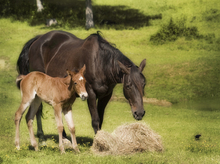In some areas, winter weather takes a heavy toll on pastures. In areas where pastures stay green all season, extra spring rainfall can create a muddy mess. In areas where snow and ice accumulate, spring grazing can demolish green plants as they emerge from the ground.

Keeping horse pastures healthy
Weather can take a heavy toll on pastures, but no matter where you live, a little extra care can keep your pasture and your horses healthy.
No matter where you live, a little extra care can keep your pasture and your horses healthy.
Follow these five tips for keeping your pasture healthy:
- Keep horses out of fields when the ground is very wet. On drier days, turn horses out in pairs or small groups for short periods of time rather than allowing full turnout.
- Place small piles of hay in the field in several areas, preferably not right next to fences and gates. Horses will still graze winter pastures, but instead of biting off the upper parts of growing plants, they tend to pull entire dormant plants completely out of the ground. If hay is offered in the pasture, this damage is somewhat minimized.
- Consider adding material to the part or all of the paddock to protect the ground surface and avoid mud. This can be sand, compacted crushed rock, wood chips, or rubber mats, shreds, or paving blocks. The surface should be several inches deep, non-slippery, and fairly easy to clean. Loose material like wood chips will break down slowly, and more material will need to be added from time to time. Think about using something quite durable, such as rubber mats, near gates and water supply where traffic will be heaviest.
- If possible, create one or more paddocks where horses can be turned out when the ground is too wet to allow full pasture access. The paddock should be large enough for horses to move around freely and should not be crowded with too many horses. If space is limited, horses can be rotated through a single paddock so that each one has a few hours out of the stall during the day.
- Remove manure as needed, at least once a day but more often if the paddock gets frequent use.
If horses have been kept off pasture all winter, remember to introduce grazing gradually in the spring. Begin with brief periods of turn-out time several times a day and lengthening the hours until the pasture is drier and has re-established plant growth.
Continue to offer hay in the stall and in the field. This gradual reintroduction allows the horse’s digestive tract to adapt slowly to the change in diet and allows the pasture to establish a healthy dose of green growth.
A rule of thumb for stocking density on pasture for equine is 2 acres of healthy, well-managed and fertile pasture per 1,000-pound horse. According to Krishona Martinson, University of Minnesota Extension equine specialist, this stocking rate should provide most of a horse’s nutrition during the typical spring and summer growing season.
Note: THis still timely article was first published on EquiMed.com in 2013.
